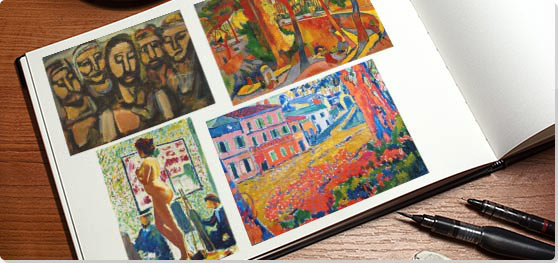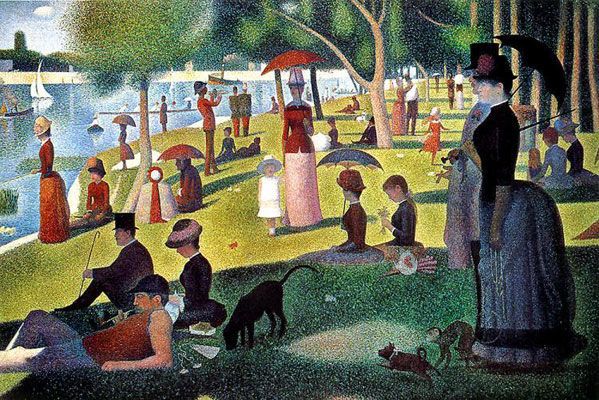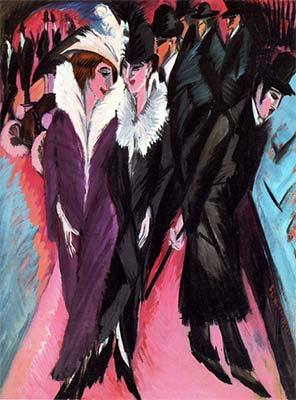Summary of Fauvism
Fauvism, the first 20th-century movement in modern art, was initially inspired by the examples of Vincent van Gogh, Paul Gauguin, Georges Seurat, and Paul Cézanne. The Fauves ("wild beasts") were a loosely allied group of French painters with shared interests. Several of them, including Henri Matisse, Albert Marquet, and Georges Rouault, had been pupils of the Symbolist artist Gustave Moreau and admired the older artist's emphasis on personal expression. Matisse emerged as the leader of the group, whose members shared the use of intense color as a vehicle for describing light and space, and who redefined pure color and form as means of communicating the artist's emotional state. In these regards, Fauvism proved to be an important precursor to Cubism and Expressionism as well as a touchstone for future modes of abstraction.
Key Ideas & Accomplishments
- One of Fauvism's major contributions to modern art was its radical goal of separating color from its descriptive, representational purpose and allowing it to exist on the canvas as an independent element. Color could project a mood and establish a structure within the work of art without having to be true to the natural world.
- Another of Fauvism's central artistic concerns was the overall balance of the composition. The Fauves' simplified forms and saturated colors drew attention to the inherent flatness of the canvas or paper; within that pictorial space, each element played a specific role. The immediate visual impression of the work is to be strong and unified.
- Above all, Fauvism valued individual expression. The artist's direct experience of his subjects, his emotional response to nature, and his intuition were all more important than academic theory or elevated subject matter. All elements of painting were employed in service of this goal.
Overview of Fauvism

Born to a family of weavers, and growing up in Bohain-en-Vermandois, as a child Henri Mattise was influenced by the bright colors and patterns of local textiles. His primal feeling for color (the very basis of Fauvism) was reawakened when, as a young man he returned home to convalesce from appendicitis, and his mother gave him a paint box. He later said, "From the moment I held the box of colors in my hands, I knew this was my life. I threw myself into it like a beast that plunges toward the thing it loves."
Artworks and Artists of Fauvism
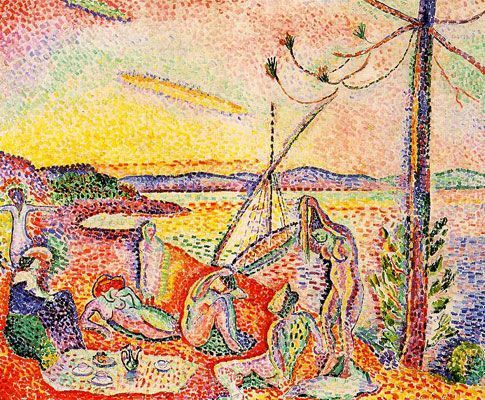
Luxe, Calme et Volupte
This early work by Matisse clearly indicates the artist's stylistic influences, most notably Georges Seurat's Pointillism and Paul Signac's Divisionism, in the use of tiny dabs of color to create a visual frisson. What sets this work apart from these more rigid methods, however, is Matisse's intense concentrations of pure color. The oranges, yellows, greens, and other colors all maintain their own discrete places on the picture plane, never quite merging to form the harmonious tonality that both Seurat and Signac were known for, and instead heighten the almost vertiginous effect created by the striking dots of paint. Matisse took this work's title, which translates as "luxury, peace, and pleasure," from Charles Baudelaire's poem L'Invitation au Voyage (Invitation to a Voyage).
Oil on canvas - Musée National d'Art Moderne, Paris
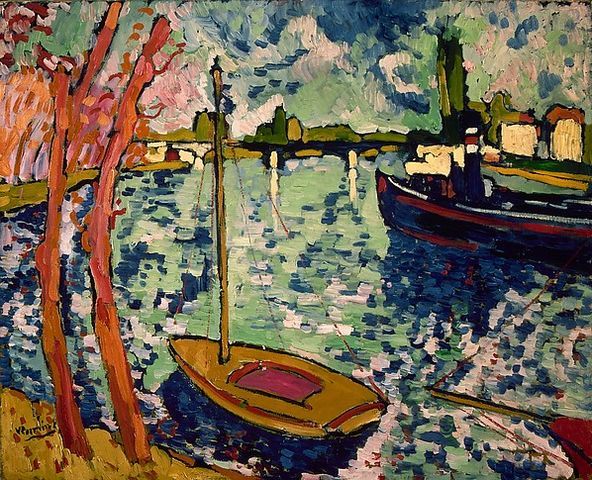
The River Seine at Chatou
This scene depicts the portion of the Seine that runs through Chatou, the Paris suburb where de Vlaminck and Derain shared a studio beginning in 1901. For The River Seine, de Vlaminck used impasto (a technique practiced by many Fauves): thick daubs of paint applied directly from the tube, then brushed together in short strokes to create the effect of movement. For the water and sky, de Vlaminck used a range of blues and greens, as well as dazzling white highlights applied in choppy dabs; the two red-and-orange trees at the left provide a lively contrast. The finished effect is one of brightness and vibrating motion; detail and traditional perspective matter far less than a sense of buoyant pleasure. As de Vlaminck said, "I try to paint with my heart and my guts without worrying about style."
Oil on canvas - The Metropolitan Museum of Art, New York
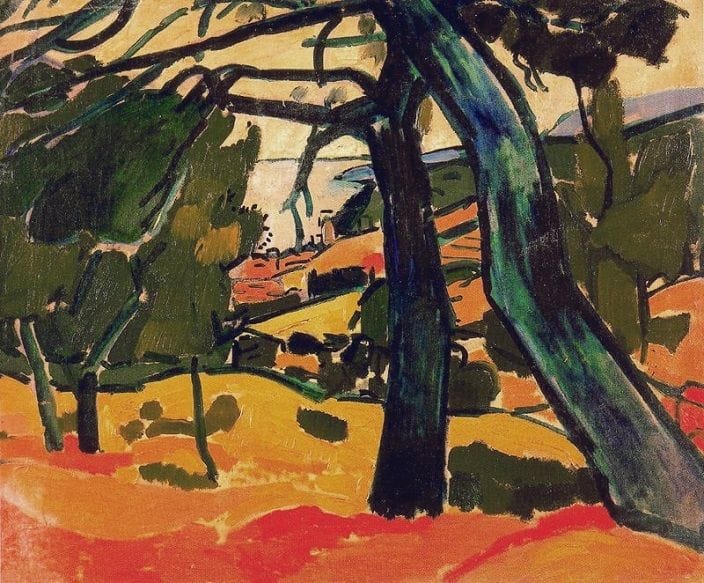
Pinède à Cassis (Landscape)
Derain famously claimed to use "color as a means of expressing my emotion and not as a transcription of nature." In this painting (just as in his famous Mountains at Collioure (1905)) Derain used long, isolated brushstrokes, influenced by Divisionist painting, to structure the trees and ground of his landscape. The colors are indeed non-representational, even unnatural: the trees' trunks are almost green, and the landscape is abstracted in patches of bright yellow and orange. The pulsing brushwork and jarring contrasts of these colors suggest the shimmering heat of a Mediterranean summer. By rejecting chiaroscuro and spatial depth, Derain keeps the viewer's attention fixed on this effect of light and on the life force that seems to ripple through every element of the landscape.
Oil on canvas - Musée Cantini, Marseille
Portrait of Henri Matisse
Derain painted this portrait of Matisse during the artists' shared summer in Collioure, when the two men were experimenting side-by-side in their work. As in most Fauvist portraiture, a detailed likeness of the subject was not the artist's goal. Derain's chief focus was to express a state of mind through the use of visible brushwork and fluid lines, both of which accentuated his applications of pure color. The sitter's right side is shadowed in violet and turquoise, and the left side of his face is highlighted in broad strokes of pink and red; this non-naturalistic use of saturated color underscores the figure's direct, intense gaze. While the background is painted in thin, vertical strokes, Matisse's head emerges more strongly in impasto brushwork, as if Derain were building it up from the paint itself, rather than through the traditional use of shading or perspective.
Oil on canvas - Collection of the Tate, United Kingdom
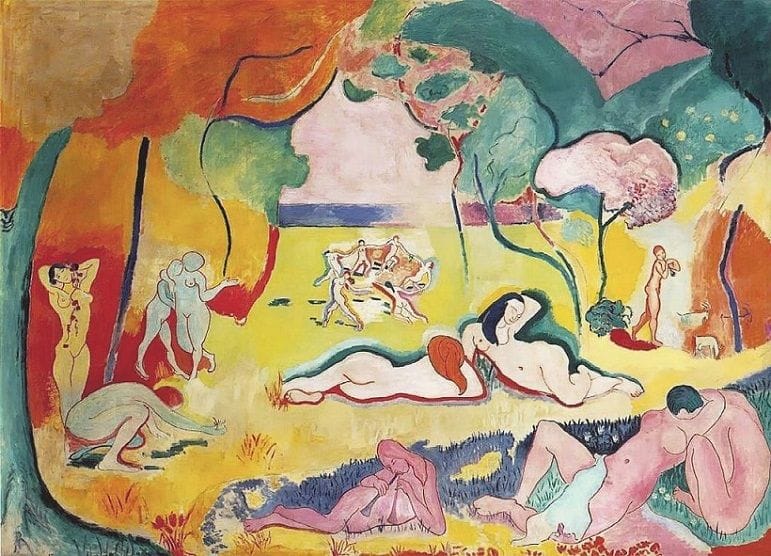
Le Bonheur de Vivre
The Joy of Life, possibly Matisse's best-known Fauvist work, was created in response to the negative critical reactions that followed Matisse's contributions to the 1905 Salon d'Automne. Although the subject of merry-making figures within a pastoral setting is a venerable one in Western art, Matisse's daring use of non-natural color to structure this enigmatic world, and his free delineation of its inhabitants, gave a fresh update to this imagery. Matisse's nudes perform activities of sensual bliss: dancing, making music, and embracing. They are connected to each other and to the vividly colored landscape by a sinuous network of curving lines and by the artist's radical use of the same pure colors for all the elements of his composition. Pairings of complementary colors (red and green, purple and yellow) produce strong visual contrasts that almost seem to vibrate, and the traditional means of suggesting depth and lighting have been eliminated. This idyllic scene unites thematic and visual influences from the Renaissance to Art Nouveau to Persian miniature painting, but it does so in a way that is undeniably modern. The Joy of Life was as influential as another large figurative canvas, Picasso's Les Demoiselles d'Avignon (1907), in its expressive reimagining of the human figure and its surroundings.
Oil on canvas - The Barnes Foundation, Merion, PA
Yacht at Le Havre Decorated with Flags
Following in the footsteps of Claude Monet and Eugene Boudin, Dufy painted numerous scenes of Le Havre, a port town located on France's northwestern coast. This view includes several docked ships against a background of local architecture. Although this imagery is largely naturalistic, Dufy's rejection of traditional perspective and his unconventional paint application are avant-garde. The abrupt diagonal line of the wharf at left, for example, has a destabilizing effect. The scene is painted in a stylized notation of quick brushstrokes: a scattering of small curved dabs for the waves, tiny blocks of color for the quayside buildings, and rough, abbreviated strokes for the forms of passing pedestrians. From the ship's mast at the center of the composition dances an array of nautical flags; each one is a small abstraction of color and shape. However, Dufy's apparently unpolished brushwork and the bare edges of the canvas do not detract from the work; instead, they evoke an overall mood of breeziness and gaiety.
Oil on canvas - Musée d'art moderne Andre Malraux, Le Havre
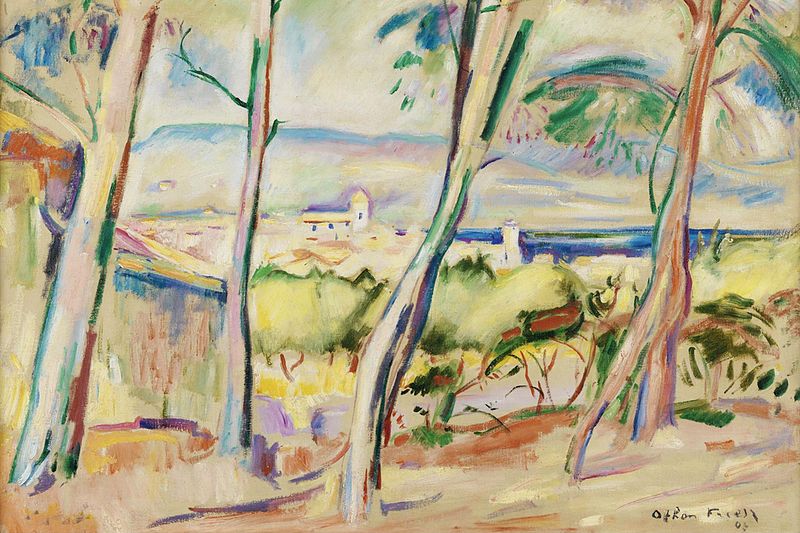
Paysage à La Ciotat
Achille Émile Othon Friesz, a native of Le Havre, moved to Paris to study art in 1898 and became part of the circle that included Matisse, Rouault, Marquet, and Dufy. He frequently traveled in search of landscapes, and from 1906 to 1907 a trip to L'Estaque and La Ciotat in southern France with his friend Braque yielded several important Fauvist works. For this view of the town, Friesz used warm and light yellow tones which he accentuated by touches of green. Although he was a devoted Fauvist for as long as any of his contemporaries, Friesz's approach to the canvas was far more traditional, his color choices were more deliberate, and his application of paint was more methodical. In this sense, Friesz painted an Impressionist-style landscape using Fauvist color.
Oil on canvas
Jeanne dans les fleurs
In the early stages of his career, newly inspired by a visit to the 1905 Salon d'Automne, Dufy painted several garden scenes inspired by his family's home in Le Havre. However, this is the only one from that period that contains a human figure. Like the Impressionists, Dufy was fond of painting gardens and flowers, but this scene of his family's garden, composed in a shallow, tightly cropped space, was a more expressive work of art. His ambiguous mingling of foreground and background through the curves of the foliage, his raw brushwork, and his non-naturalistic use of color (even in the skin of his model, his sister Jeanne) exemplify Fauvism's freedom from literal physical appearances and its new stress on color's intrinsic emotional power.
Oil on canvas - Musée d'art moderne Andre Malraux, Le Havre, France
At the Circus (The Mad Clown)
A student of Moreau and a friend of Matisse, Rouault brought a more somber, psychologically observant approach to his early Fauvist works like At the Circus. Although he shared the other Fauvists' use of impasto application and dense brushwork, he preferred darker colors that echoed his intense observation of human suffering. Like Édouard Manet and Honoré Daumier in the 19th century and his contemporary Pablo Picasso in the early-20th century, Rouault chose the subject of the circus performer. His clowns and acrobats, always shown offstage, reveal the inner pain and loneliness behind their colorful makeup. Rouault was criticized for focusing his attention on the wretched individuals at the margins of society (he also depicted prostitutes, wanderers, and physical laborers). His spiritual and artistic interests soon led him in a different direction than his fellow Fauvists: he began to paint more satirical scenes of societal inequality and the corrupt abuse of power.
Oil on cardboard - The Philadelphia Museum of Art
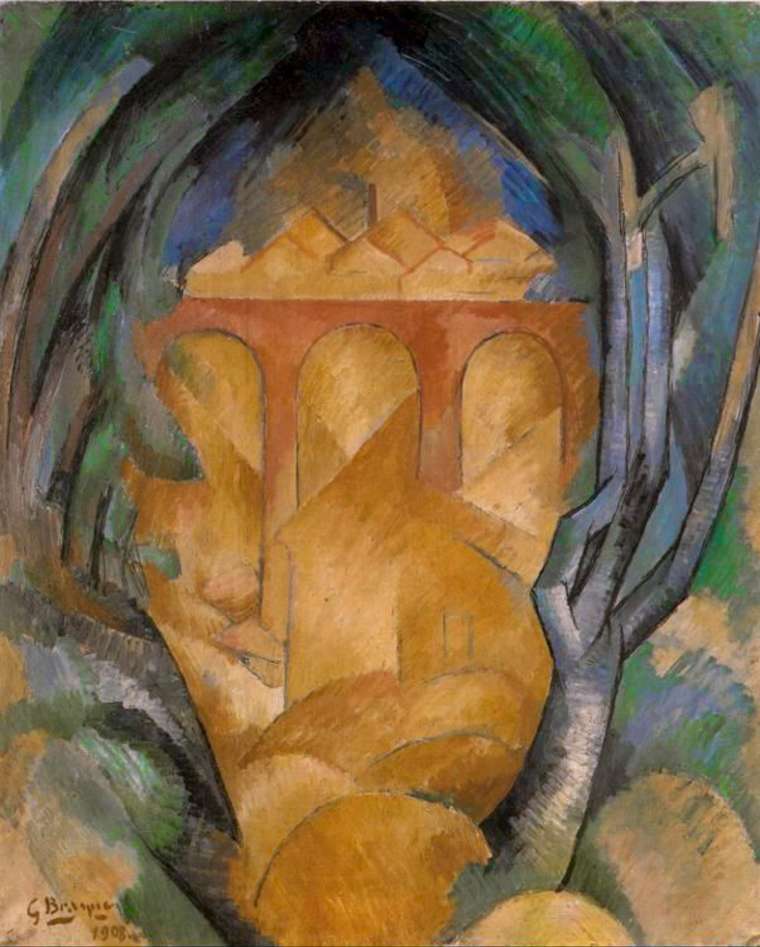
Le Viaduc à L'Estaque
Between 1905 and 1908, Braque painted the landscapes of L'Estaque (a setting also favored by Cézanne) in different color palettes. This 1908 composition reveals Braque's combination of Fauvist color and simplification of form with a nascent interest in volume and multiple perspective: the rounded arches of the ancient viaduct connect both sides of the landscape in the distance, but the foreground is a carefully arranged stack of boxy houses and vigorously brushed greenery. Le Viaduc a l'Estaque foreshadows Braque's future role in the development of Cubism, the next major modern movement of the 20th century.
Oil on canvas
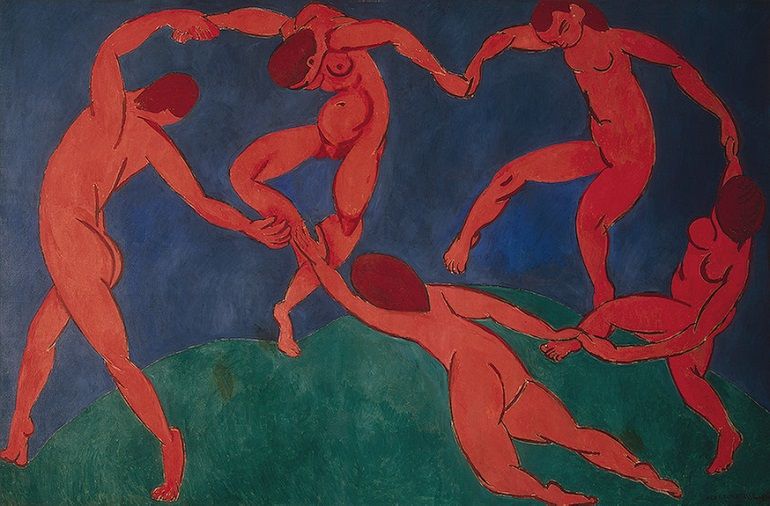
La Danse
Dance and its pendant Music were two of Matisse's late Fauvist works, the culmination of his work in this style. These large-scale canvases were commissioned by the Russian merchant Sergei Shchukin, a major patron of avant-garde art in that period. The arrangement of figures in a circular dance is a centuries-old motif, often used to suggest a golden age of harmony and leisure. However, by simplifying and distorting his dancers' anatomy for expressive purposes, and painting them in a vibrant, non-naturalistic red against a flat ground of blue sky and green earth, Matisse emphasized the primordial aspect of dance. The figures' extremities brush the edges of the composition, as if their dynamism were barely contained by the canvas. When it was first exhibited publicly, at the Salon d'Automne of 1910, Dance puzzled and shocked the audience.
Oil on canvas - The Hermitage. St. Petersburg, Russia

The Red Studio
In The Red Studio, Matisse dismantled the conventional distinctions between foreground and background, figure and space. Color and perspective are both non-naturalistic in this work: the canvas is one broad field of saturated crimson. When asked about this choice of color, Matisse commented, "Where I got the color red - to be sure, I just don't know. I find that all these things...only become what they are to me when I see them together with the color red." The delicate, pale outlines of furniture and walls are actually underpainting revealed from behind the red, and they are not consistent with any traditional perspectival system. Instead, space is flattened and exaggerated so that the viewer seems to be looking down into the studio from a raised vantage point. While this expressive use of color and space is Fauvist, the simplification of forms and static quality of The Red Studio point the way from Matisse's Fauvist phase to his growing interest in non-Western sources and his eventual association with the École de Paris.
Western masters from Rembrandt to Courbet had painted their own studios, but instead of showing himself at work as they did, Matisse evoked his creative process and inner vision. The Red Studio also includes an assortment of the artist's Fauvist paintings, as well as sculptures and ceramics, a box of pencils or pastels, a wineglass, and a potted plant that brings a note of the natural landscape into this interior setting. Ironically, the works of art appear more "real" than the abstracted room where they have been created. Certain omissions also reinforce the idea that this "studio" is a state of mind as well as an actual physical location: the left rear corner of the room lacks any defining line, and the grandfather clock has no hands to tell time.
Oil on canvas - The Museum of Modern Art, New York
Beginnings of Fauvism
In the opening years of the twentieth century, Post-Impressionist painters working in France such as Van Gogh, Gauguin, Seurat, and Cézanne were considered leaders in avant-garde art. Their collective experiments with paint application, subject matter, expressive line, and pure color were advances that fed the emergence of Fauvism. Symbolism, with its emphasis on the artist's internal vision, was another important influence. From another source, the European reassessment of African sculpture as art rather than an anthropological curiosity introduced new ideas of form and representation to the European modernists.
Matisse as Fauvist Pioneer
Henri Matisse is generally considered the principal founding artist of Fauvism. Like many of his contemporaries, Matisse was greatly influenced by Moreau's teaching that personal expression was among the most important attributes of a great painter. Also of considerable importance to the young Matisse were the techniques and systematic visual language of Pointillism, which had been spearheaded by his fellow countrymen Georges Seurat, Paul Signac, and Henri-Edmond Cross. Although Matisse did not apply Pointillist theory directly to his own work, the application of tiny dots of paint in varying colors to create a harmonious visual tone was something that fascinated Matisse. His observation of this technique led him to develop "color structure," or large, flat areas of color that established a deliberate, decorative effect and sense of mood. He was also very aware of the Post-Impressionist work of Paul Gauguin, Pierre Bonnard, and Édouard Vuillard, whose integration of solid color and design was a departure from the flickering, momentary effect of Impressionist painting.
Synthesizing all these ideas, Matisse turned away from using subtle hues of mixed paints and began working with bright color, directly from the tube, as a means of conveying emotion. He had been working outdoors since the mid-1890s, and his travels to Corsica and the south of France in 1898 increased his interest in capturing the effect of strong natural light. A summer spent working alongside Signac and Cross at Saint-Tropez on the French Riviera in 1904 gave him a further opportunity to witness their techniques.
Fellow Fauves: Derain and de Vlaminck
During the same years as Matisse's initial experimentation with Post-Impressionist techniques, the two painters André Derain and Maurice de Vlaminck met in 1901 and began sharing a studio in Chatou, a western suburb of Paris. Working closely together, they developed their new mutual interest in bold color and directional brushwork.
Matisse met Derain in 1899, and two years later, through Derain, he met de Vlaminck. As an older and more established artist, he supported and encouraged these two kindred spirits, even introducing them to prospective dealers. In 1905 Matisse visited the studio in Chatou, where he was strongly impressed by de Vlaminck's use of pure color. Matisse invited Derain to spend the summer of 1905 with him in Collioure, a port and fishing town located on the southern coast of France. The two men spent this breakthrough summer working and refining their styles and techniques, producing numerous significant paintings during a crucial four-month period of collaboration.
The 1905 Salon d'Automne
Later that year, the Salon d'Automne exhibition was held at the Grand Palais in Paris. Matisse, Derain, and de Vlaminck all exhibited works in this show; they were joined by other former students of Moreau, including Henri Manguin and Albert Marquet. The paintings on display were quite distinctive in their use of vivid, saturated color and spontaneous brushwork. Also included in the exhibition was a more traditional-looking sculptural bust by Albert Marque, and this figure's proximity to the garishly colored, energetically executed paintings prompted the critic Louis Vauxcelles to describe the scene as "Donatello parmi les fauves" ("Donatello among the wild beasts"). The term "Fauves" was thus coined for these artists; although it was pejorative in its original context, it endured.
Fauvism: Concepts, Styles, and Trends
An Expanding Circle
Despite initial hostility from critics, many of the Fauves enjoyed commercial success following the Salon d'Automne exhibition of 1905. Their art was featured at additional exhibits held over the following years, notably at the Salon des Indépendants in 1907, where the main attraction was a large room dubbed "The Fauves' Den." Meanwhile, other artists began to join the central trio of Matisse, Derain, and de Vlaminck. The expanding group of Fauves (all based in France) eventually included Othon Friesz, Georges Rouault (another student of Gustave Moreau), Kees van Dongen, Georges Braque, and Raoul Dufy. These artists traveled together, shared studios, and exchanged ideas freely during the rather brief heyday of Fauvism.
The Primacy of Color
All the Fauves were intensely preoccupied with color as a means of personal expression. Color and the combination of colors constituted the intrinsic subject, form, and rhythm of their work. A sky could be orange, a tree could be blue, a face could be a combination of seemingly clashing colors; the end result was a wholly independent product of the artist's perception, rather than a faithful depiction of the original physical form. Additionally, compositional elements were built up through the placement of color, rather than through perspectival systems or draftsmanship.
Subject and Style
In their shared preoccupation with expression through color and form, these artists were generally less concerned with the novelty of their subject matter. Whereas the Impressionists and Post-Impressionists had depicted scenes of modern, urban life, such as the boulevards, cafés, and concert halls of Paris, the Fauves took more traditional subjects as their starting points. Their subject matter drew from the world around them and included portraits, landscapes, seascapes, and figures in interiors, but the visual impact of the color composition took primacy over any possible narrative or symbolism. Instead, they used their subjects as vehicles for the acts of observation and painting, with their active brushwork and non-naturalistic color as means of leading the viewer into their inner, creative journeys.
Later Developments - After Fauvism
The Fauves' tendency to distort form and color in order to express inner sensations was a strong influence on the Expressionists, whose own artistic movement proved much longer-lived and more cohesive. The German Expressionists, led by such artists as Ernst Ludwig Kirchner and Karl Schmidt-Rottluff, employed a similarly aggressive use of color in their bustling Berlin street scenes and frequently grotesque portraiture.
Cézanne and Cubism
In a sense, Fauvism's demise can be also attributed to a renewal of interest in Cézanne. A Cézanne exhibition held in Paris in 1907 revived attention in the artist's work, particularly his emphasis on natural order and structure. Georges Braque, for example, began to favor a more restricted color palette, focusing more on subtle gradations of color and scale. This approach led Braque to fill his canvases with a crowded yet carefully ordered abundance of shapes and forms, as in his 1908 work Road near L'Estaque, which is unmistakably a crucial precursor to the artist's development of the Cubist style.
African Art
In another interesting crossover during this era, the Fauves' and Pablo Picasso's circles were both interested in African art. Matisse's travelled to Morocco acquired new ideas about color and pattern that surfaced in works like The Green Line (Portrait of Madame Matisse) (1905) and Blue Nude (Souvenir of Biskra) (1907), with their radically simplified features and angular limbs inspired by African sculpture. This use of non-Western artistic sources also had a profound influence on the younger Picasso; he began to incorporate African and Iberian masks into his own work, including in a number of self-portraits and in the iconic Les Demoiselles d'Avignon (1907).
By 1908 the Fauves were individually venturing in separate directions: Braque began developing Cubism alongside Picasso, Derain briefly flirted with Cubism as well, and de Vlaminck darkened both his palette and subject matter. Meanwhile, other artists in the group, such as Marquet, Dufy, and Rouault, had begun to work in other styles.
Aftermath
Ultimately, the Fauves joined together for a short but highly consequential episode, rather than a fully defined school. Although they never produced a group manifesto outlining their artistic aims, Matisse's "Notes of a Painter," written in 1908, formalized many of their shared concerns and goals, including their commitment to personal expression and individual instinct, their use of color as an independent visual element with an emotional effect, and their rethinking of composition as pictorial surface. Even after the dissolution of the group, nearly as soon as it gained its infamous nickname, Fauvism's ideas and landmark works would continue to influence art for decades to come.
Useful Resources on Fauvism
- FauvismOur PickBy Sarah Whitfield
- Fauve Painting: The Making of Cultural PoliticsBy James D. Herbert
- The FauvesOur PickBy Nathalia Brodskaia
- The Fauves: The Reign of ColourBy Jean-Louis Ferrier
- The "Wild Beasts": Fauvism and Its AffinitiesBy John Elderfield
- The Fauve LandscapeBy Judi Freeman, James Herbert, John Klein, Alvin Martin, and Roger Benjamin
 Ask The Art Story AI
Ask The Art Story AI